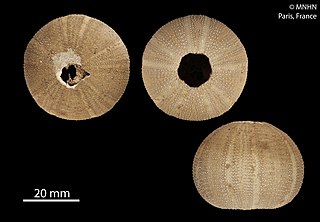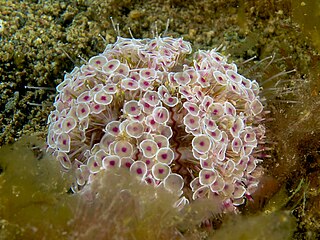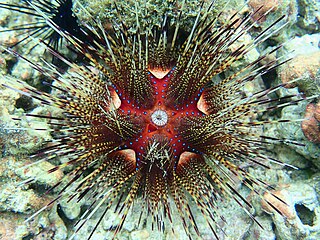
Lytechinus variegatus, commonly called the green sea urchin or the variegated sea urchin, is a species of sea urchin that can be found in the warm waters of the western Atlantic Ocean and Caribbean Sea.

Petricola is a genus of saltwater clams, marine bivalve molluscs in the subfamily Petricolinae of the family Veneridae, the Venus clams.

Heterocentrotus trigonarius, commonly known as the slate pencil urchin or red slate pencil urchin, is found in the tropical waters of the Indo-Pacific region. Heterocentrotus mamillatus is a similar, related species.
Cassiduloida is an order of sea urchins. The group was extremely diverse with many families and species during the Mesozoic, but today, only seven extant species remain.

Clavatula is a genus of sea snails, marine gastropod mollusks in the family Clavatulidae.

Ancilla, common name the ancillas, is a genus of sea snails, marine gastropod mollusks in the family Ancillariidae.

The subfamily Emarginulinae, common name keyhole limpets and slit limpets, is a taxonomic subfamily of limpet-like sea snails, marine gastropod molluscs in the family Fissurellidae, the keyhole limpets and slit limpets.

Amblypneustes ovum is a species of sea urchin of the family Temnopleuridae. Their armour is covered with spines. It is in the genus Amblypneustes and lives in the sea. Amblypneustes ovum was first scientifically described in 1816 by Jean-Baptiste de Lamarck.

Amblypneustes pallidus is a species of sea urchin of the family Temnopleuridae. Their armour is covered with spines. It is in the genus Amblypneustes and lives in the sea. Amblypneustes pallidus was first scientifically described in 1816 by Jean-Baptiste de Lamarck.

Toxopneustes is a genus of sea urchins from the tropical Indo-Pacific. It contains four species. They are known to possess medically significant venom to humans on their pedicellariae. They are sometimes collectively known as flower urchins, after the most widespread and most commonly encountered species in the genus, the flower urchin.

Eucidaris is a genus of cidaroid sea urchins known as slate pencil urchins. They are characterised by a moderately thick test, a usually monocyclic apical disc, perforate and non-crenulate tubercles and nearly straight ambulacra with horizontal pore pairs. The primary spines are few and widely spaced, stout with blunt flat tips and beaded ornamentation and the secondary spines are short and apressed. They originated in the Miocene and extant members of the genus are found in the tropical Indo-Pacific Ocean, East Pacific, Atlantic Ocean and Caribbean Sea.

Astropyga pulvinata is a species of sea urchins of the family Diadematidae. Their armour is covered with spines. Astropyga pulvinata was first scientifically described in 1816 by Jean-Baptiste de Lamarck.
Calymne relicta is a species of sea urchins of the Family Calymnidae. Their armour is covered with spines. Calymne relicta was first scientifically described in 1877 by Thomson.
Cassidulus infidus is a species of sea urchin of the family Cassidulidae. Their armour is covered with spines. Cassidulus infidus was first scientifically described in 1948 by Ole Theodor Jensen Mortensen.

Toxopneustes maculatus is a rare species of sea urchin found in the Indo-West Pacific.

Clypeasteridae is a family of sea urchins in the order Clypeasteroida. This family was first scientifically described in 1835 by the Swiss-American biologist Louis Agassiz.

The Ancillariidae is a taxonomic family of sea snails, marine gastropod molluscs in the superfamily Olivoidea. They are gastropods, which belong to the larger group of mollusks. This family is part of the superfamily Cypraeoidea, which includes cowries, a well-known group of sea snails.

Parechinus angulosus, the Cape urchin, is a sea urchin in the family Parechinidae endemic to southern Africa. It is the only species in the genus Parechinus.

Fibularia is a genus of echinoderms belonging to the family Fibulariidae. The genus has almost a cosmopolitan distribution.
Rhyncholampas is a genus of echinoderms belonging to the family Cassidulidae.

















